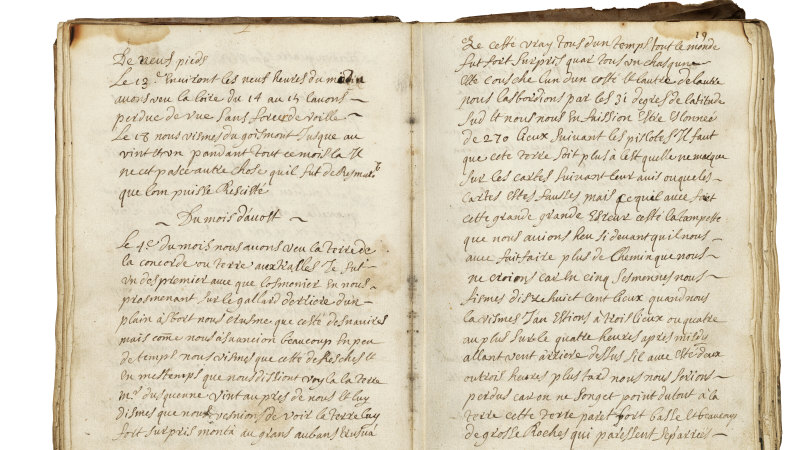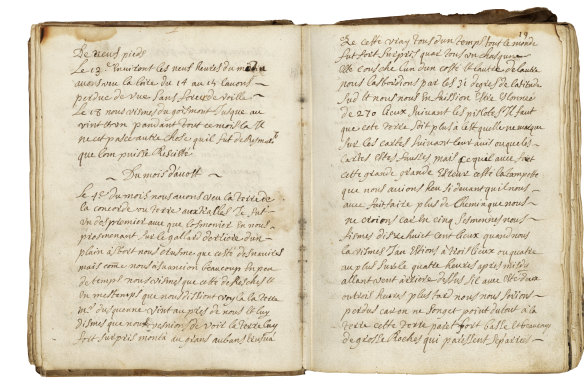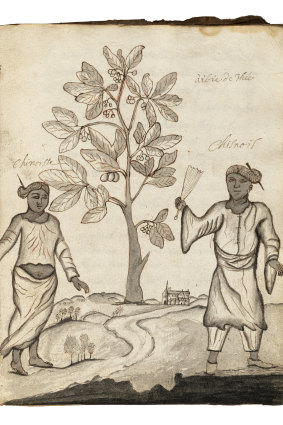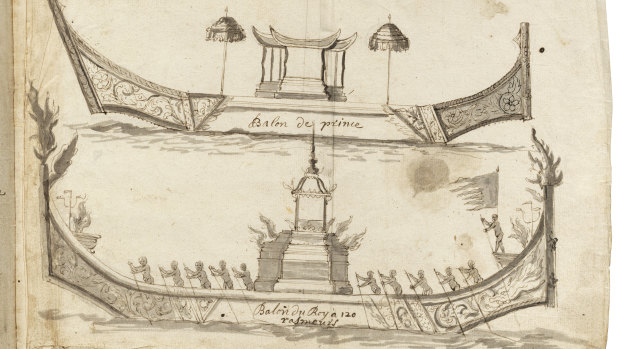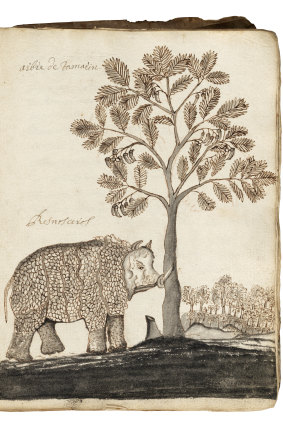London: A newly discovered 330-year-old journal that contains an eyewitness account of the first verified French sighting of the Australian coastline is expected to fetch more than half a million dollars when it goes up for auction in London this month.
Unpublished and unknown to historians, the handwritten diary of the Louis XIV royal fleet’s senior surgeon, known only as “Bremond”, recounts the voyage of the L’Oiseau under Captain Abraham Duquesne-Guitton, as part of a second French mission to Thailand in 1687.
A page from the handwritten French journal that describes Australia in 1687.Credit: Christie’s Images Limited 2023
Five ships left Brest, a port city in north-western France, on March 1, and sailed to Cape Town, from where they departed on June 28 aiming for Batavia, now Jakarta. But a week of violent storms drove them further east than planned, causing their unexpected landfall in Western Australia, north of the mouth of the Swan River.
The journal, which will go on sale in the region of £350,000 ($643,105) through Christie’s Private Sales, is thought to be the only 17th-century manuscript description of Australia to have come to the market – by some way the earliest mention of Australia ever offered for sale.
The voyage described in Bremond’s journal formed part of a flurry of diplomatic exchanges between Siam and the French court of Louis XIV over a decade, and was led by the diplomat and mathematician Simon de la Loubere and Claude Ceberet, a director of the French East India Company.
The mission also comprised 14 Jesuit scientists under Pere Guy Tachard, and a considerable military force carried in five warships – including Bremond’s L’Oiseau – of 46 guns.
Thomas Venning, head of books and manuscripts at Christie’s in London, said such a find was “extremely rare”.
“In 25 years as an autographs specialist at Christie’s, I’ve never seen anything similar,” he said.
Venning said when his research showed up that the ship had made an unexpected landfall on the Australian coast he started frantically turning the journal’s pages to see what Bremond had said about it.
Bremond’s sketch of a Javanese man and woman with a papaya tree.Credit: Christie’s Images Limited 2023
“It was a really heart-in-mouth moment,” he said. “I had no idea if he would describe it at all! When I saw the words Terra Australis (or ‘terre auxtralles’ in this rather eccentrically spelled French) in a manuscript written in 1688, I was completely dumbstruck.”
Translated from French, Bremond records seeing “Eendrachtsland or Terra Australis” on August 4.
“I was one of the first [to see it] with the chaplain as we walked on the poop. At first sight, we thought that it was some ships but as we sailed onward at speed in a short time we saw that it was rocks,” he wrote.
“At the same time as we were saying ‘there’s land’, Mr Duquesne came close to us, and we said to him that we had just seen land; he much surprised climbed the main shrouds [and] found that it was true. All of a sudden, everyone was much surprised, for everyone was packed one next to another.”
Bremond, who wrote that the fleet had been blown off course days earlier due to a storm, said that they did not precisely know by what people inhabited the land.
“Perhaps there is no one but for a few people; what makes one think this is that the earlier navigators having been in these lands found the mark of the foot of a man which was a foot and a half long.”
A sketch of the King of Siam’s barge with oarsmen, and a prince’s barge.Credit: Christie’s Images Limited 2023
The visit of L’Oiseau to Western Australia is the first verified French sighting of Australia, with historians recording it as the 33rd verified sighting of the coast by any European vessel. The sighting was noted at least as early as 1741 in Jacques-Nicolas Bellin’s chart of the Indian Ocean.
In diplomatic terms, the French embassy achieved little beyond the confirmation of the commercial treaty negotiated in 1685 and the establishment of French troops at Bangkok and Mergui. The resentment of this foreign military presence is thought to have been a significant factor in the 1688 revolution in Siam, which ultimately led to the interruption of relations between Siam and France until the 19th century.
Bremond’s journal begins with an account of the voyage from Brest along the west African coast, where the crew are affected by scurvy, before recording their stay at Cape Town. After leaving South Africa the ship runs into heavy storms between July 2 and 9, which leave it with a broken mainyard and split sail, and separate it from the other ships.
A sketch of a rhinoceros and a tamarind tree from the journey.Credit: Christie’s Images Limited 2023
After the unexpected encounter with the Australian coast, they sail north, sighting Java and passing through the Sunda Strait. Upon reaching Batavia, he describes it as “the most beautiful town of all the East Indies”, noting a significant Chinese population.
The journal includes a detailed list of the presents sent by Louis XIV and drawings illustrate the topography, local inhabitants, flora and fauna of the Cape, Batavia, Siam, the Nicobar Islands, Puducherry and Ascension Island. The 12 illustrations devoted to Siam also depict King Narai’s palace, ships and elephant.
Little more is known about Bremond, apart from records that show he continued in his career for 20 more years after 1688, including service at Toulon, the major French naval port on the Mediterranean coast.
Venning said the journal’s historical importance had been previously overlooked – it is thought to have only changed hands once, when it was sold at auction in Christie’s Paris in 2012 to the current owner. Before 2012, it was in the library of a well-connected family in western France where the manuscript was written.
“We can speculate that it had been there since shortly after it was written, but there is no way of knowing for sure,” he said.
Get a note directly from our foreign correspondents on what’s making headlines around the world. Sign up for the weekly What in the World newsletter here.
Most Viewed in World
From our partners
Source: Read Full Article
